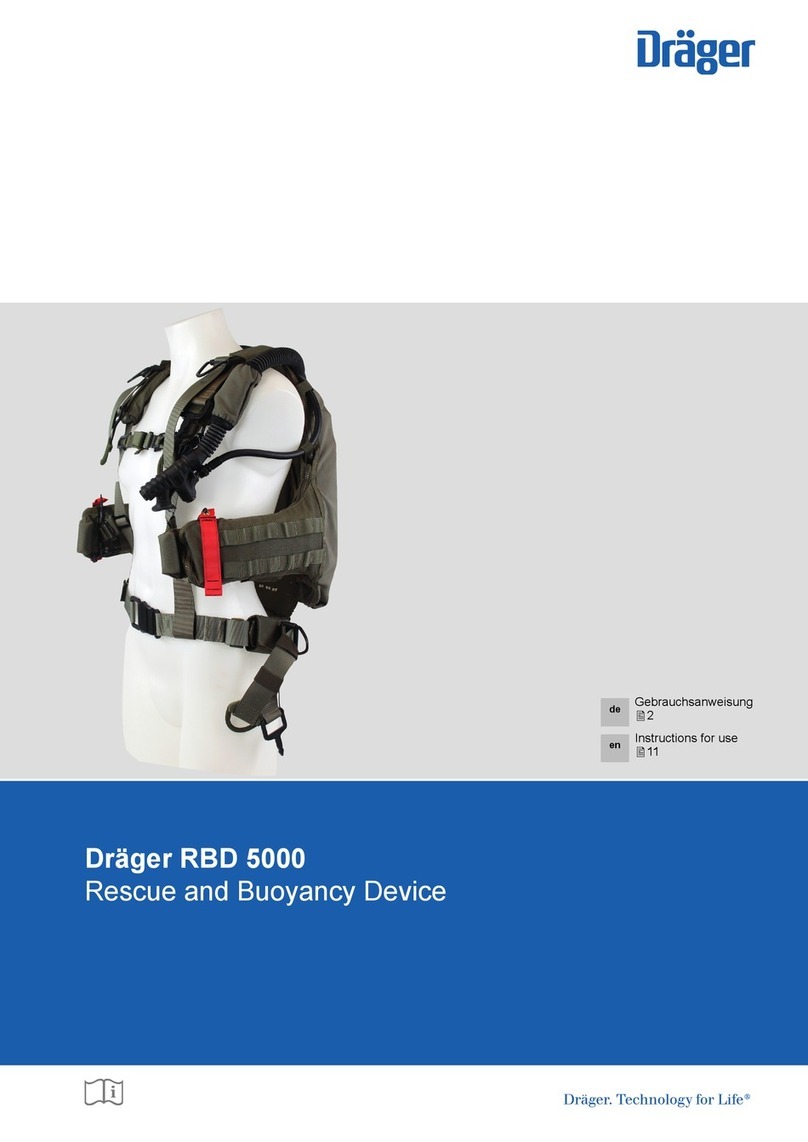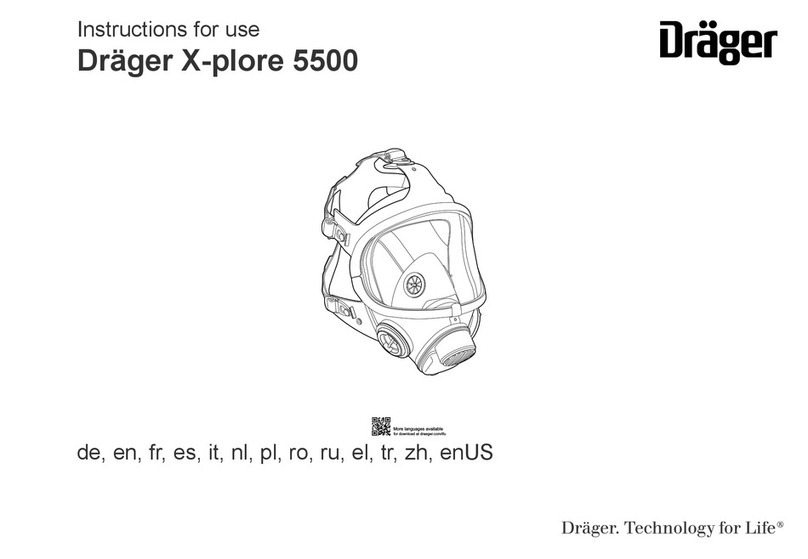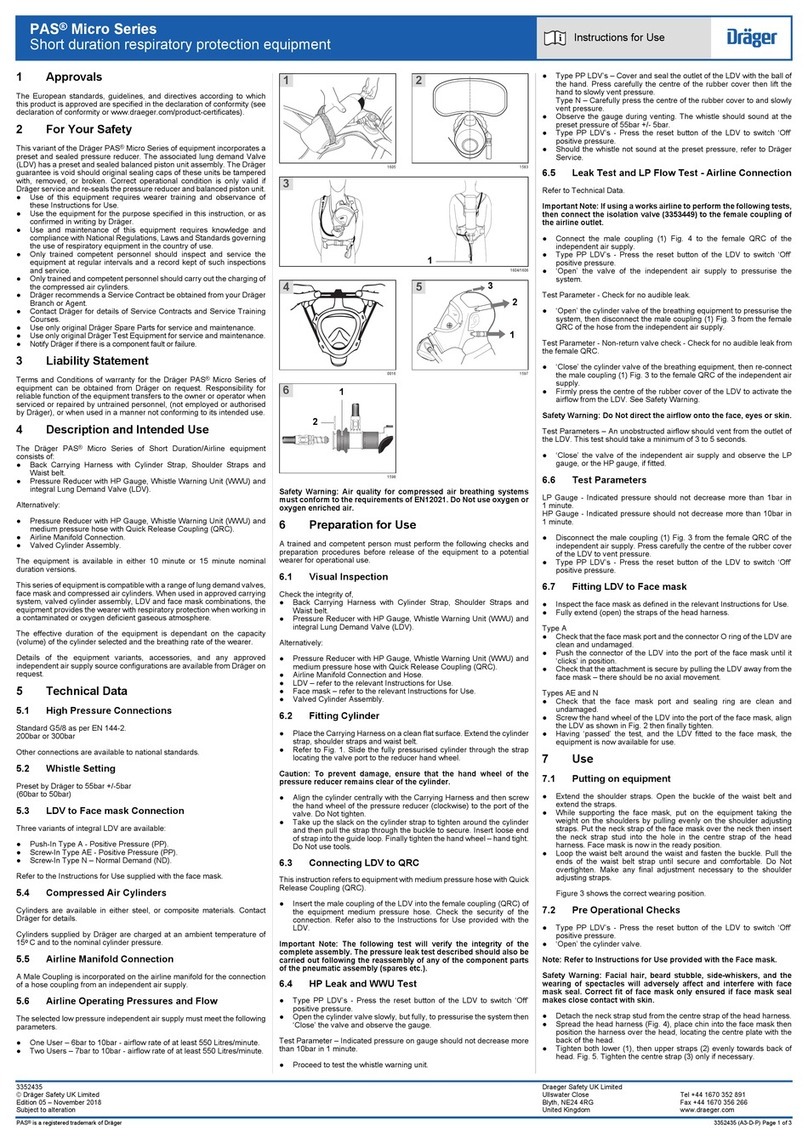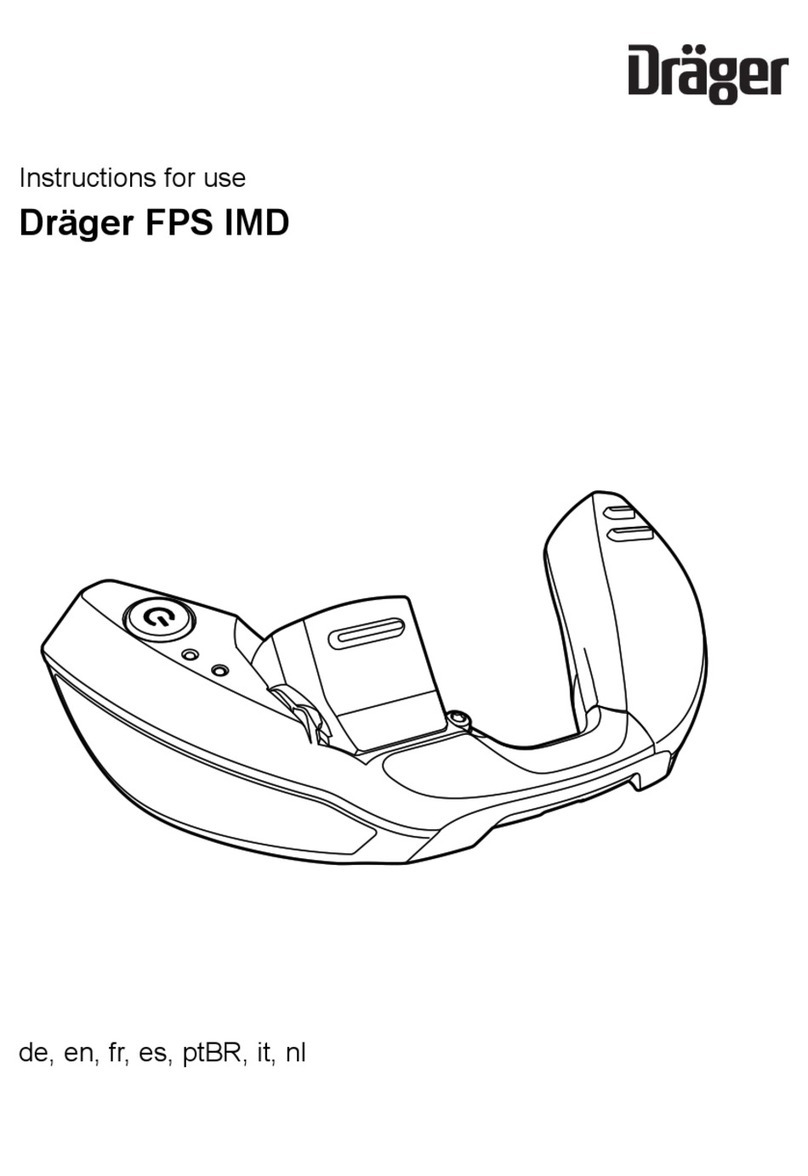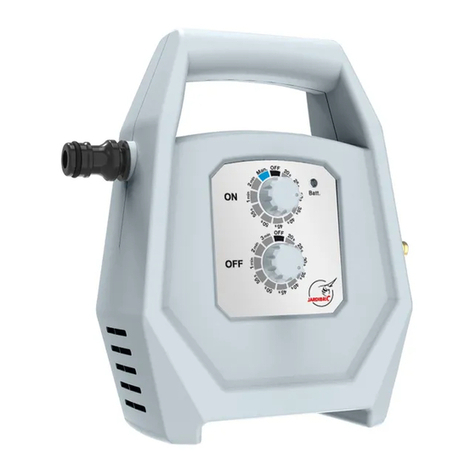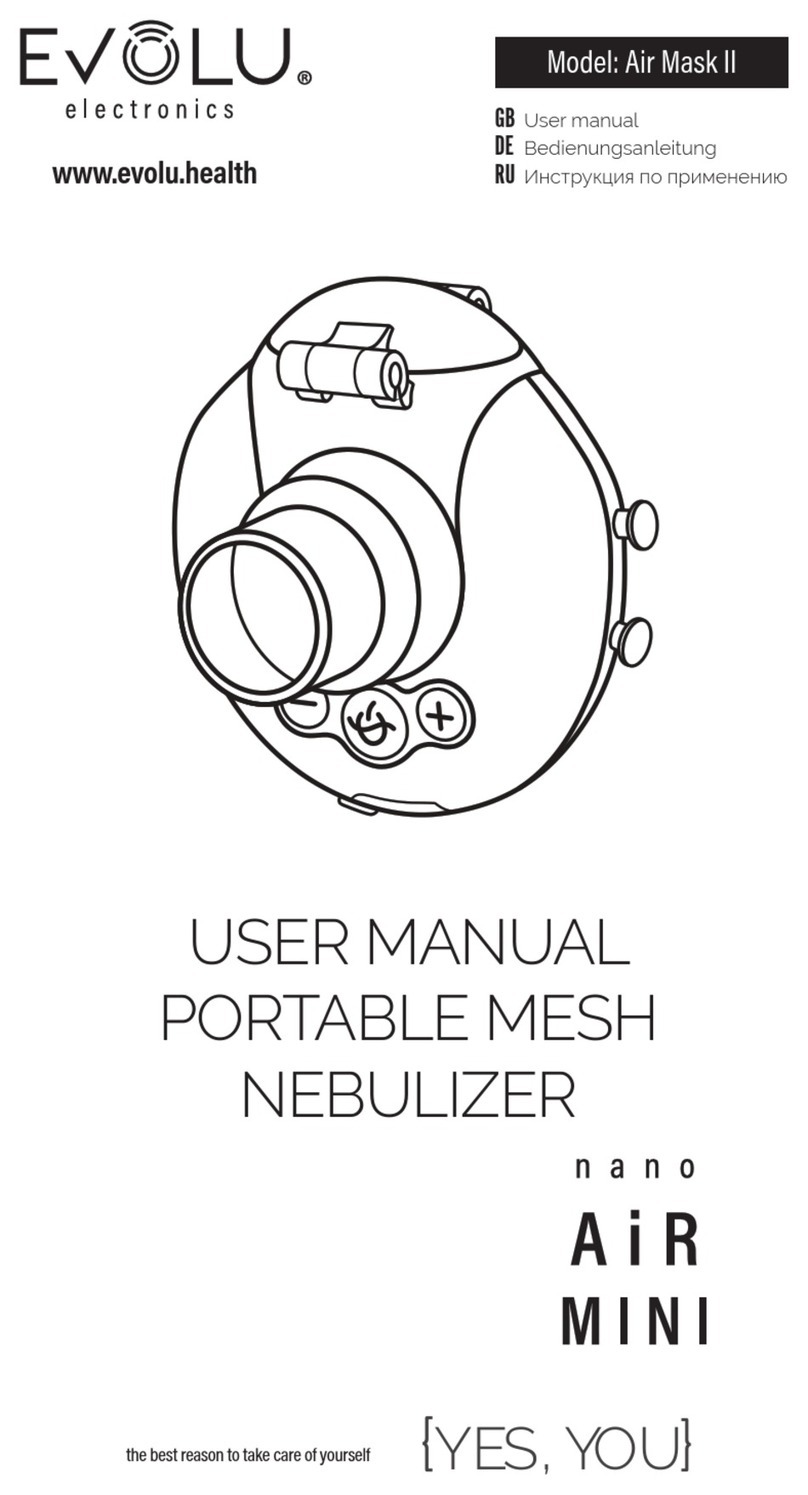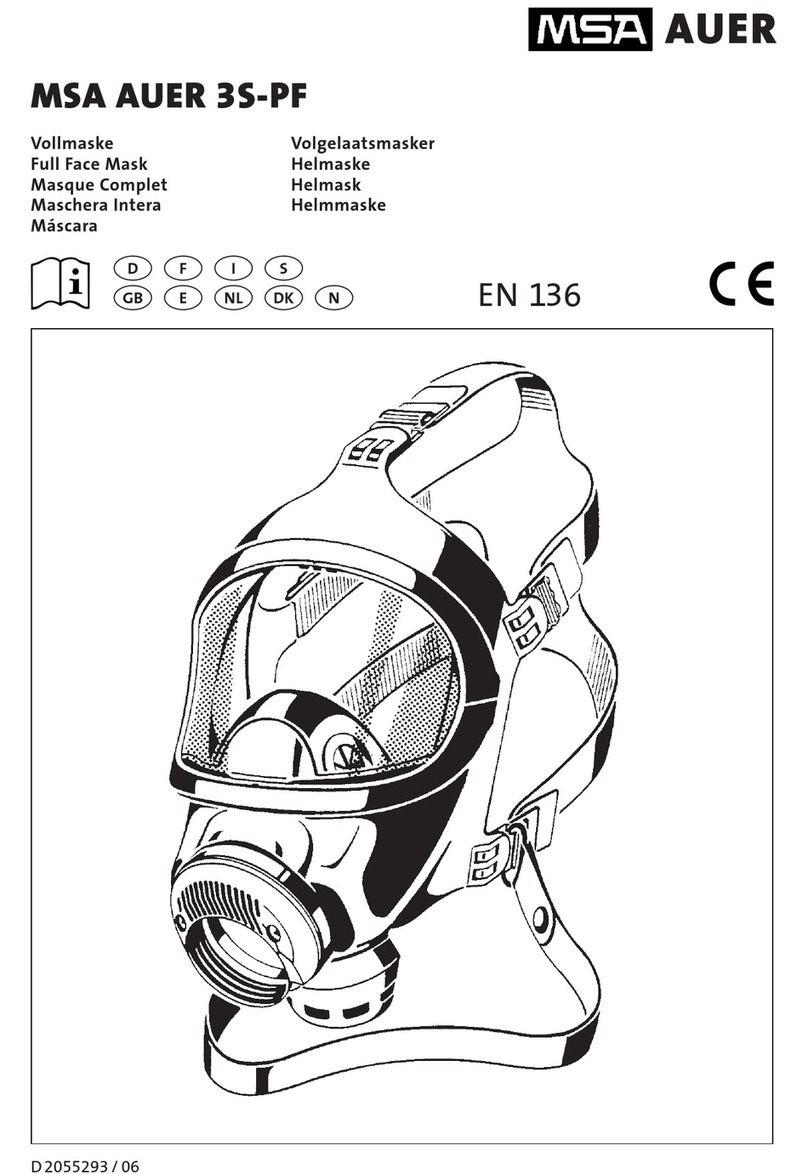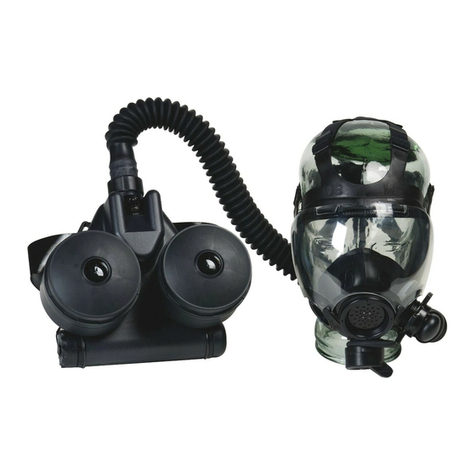
PAS®Colt Series
Bandolier short duration/Airline compressed air respiratory protection equipment Instructions for Use
Dow Corning®and Molykote®are registered trademarks of Dow Corning Corporation 3352425 (A3-D-P) Page 2 of 3
●Detach the neck strap stud from the centre strap of the head harness.
●Spread the head harness (Fig. 3). Drop the head forward and place
chin into the chin cup of the face mask, position harness over the head
locating harness centre plate with back of the head.
●Refer to Fig. 4. Tighten both lower (1), then upper straps (2) evenly
towards back of the head. Check and if necessary, tighten the centre
strap (3).
●On achieving a face seal and on taking first breath inhalation the Type
P and PE LDV’s will automatically switch to positive pressure starting
the air supply to the face mask.
●Check that the head has a full range of movement without pulling
against the LDV hose. If any resistance to movement is felt, re-adjust
the hose routing and then recheck. If resistance is still felt, Do Not use
the breathing apparatus and contact Dräger.
●Breathe normally, and before use perform Function Check.
7.3 Function Check
●‘Close’ the cylinder valve. Breathe normally to vent the system of air.
When vented, the face mask should hold onto the face indicating a
positive seal. Immediately turn ‘Open’ the cylinder valve and breathe
normally.
Note: If a leak is detected, readjust the head harness and retest.
●Inhale and hold breath. Unit must balance, i.e. no audible leak.
●Continue breathing normally. The expired air should flow easily out of
the exhalation valve of the face mask.
●Press the centre of the rubber cover of the LDV to activate and check
supplementary airflow from the LDV then release the button.
●Continue breathing and proceed to the working area, alternatively refer
to Airline Use.
Safety Warning: The duration starts from the time of opening the
cylinder valve and fitting the face mask. The effective duration is
dependant on the capacity (volume) of the cylinder selected and the
breathing rate of the wearer.
●When not connected to the independent air supply, take gauge reading
regularly. The WWU will sound at the preset pressure. Go on to a safe
area at least when the whistle sounds, by the shortest and safest route.
7.4 Airline Use
Safety Warning: Before using the airline manifold connection to the
equipment, ‘check’ that the independent air supply to be used
complies with air quality, pressure and flow requirements (see
Technical Data) and that a ‘Permit for Use’ has been issued. The
respirable breathable air supply source connection to the wearer
must be located in, or positioned in a safe and uncontaminated area.
Dräger recommend that a ‘Controller’ must be present at all times at
the air source connection to monitor and maintain the air supply to
the wearer of the Dräger PAS Colt Series Airline equipment.
7.5 The Controller
●‘Close’ any relief valves that may be fitted to the independent air supply
and then slowly, but fully, ‘Open’ the valve of the independent air
supply to pressurise the system.
7.6 The Wearer
●Put On the equipment and perform pre-operational and functional
checks as already described.
●Before entering, or when in the working area, connect the male
coupling (1) Fig. 2 to the female QRC of the ‘Open’ independent air
supply. Breathe normally then immediately ‘Close’ the cylinder valve of
the equipment. The air supply to the wearer is now from the
independent air supply.
7.7 The Wearer – Evacuation
●Breathe normally.
●When the task is completed, or when advised by the ‘Controller’ -
proceed to the safe area (Controller). During evacuation take care to
hold and carefully withdraw the airline supply hose. See After Use.
Important Note: If it is decided to evacuate the working area without
the airline connected, then proceed as follows:
●‘Open’ the cylinder valve of the equipment (anticlockwise) slowly, but
fully. Breathe normally and then disconnect the male coupling (1)
Fig. 2 from the female QRC of the hose from the independent air
supply. Breathe normally and immediately leave the hazardous area
by the shortest and safest route.
Safety Warning: The remaining duration starts from the time of
opening the cylinder valve and disconnecting the independent air
supply. The time required to allow the wearer to evacuate to a safe
area must be within the remaining capacity (volume) of air in cylinder
selected taking into account the breathing rate of the wearer. When
in an evacuation scenario Dräger strongly advise that the
supplementary supply facility is not used.
●Take gauge reading regularly. The WWU will sound at the preset
pressure.
8AfterUse
Safety Warning: Do Not remove equipment until in safe area, clear of
hazard.
8.1 SDBA Mode
●Release the side straps of the head harness.
●Remove the face mask then ‘Close’ the cylinder valve.
8.2 Airline Mode - The Wearer
●Release the side straps of the head harness.
●Type A and AE - Press the reset button of the LDV to switch ‘Off’
positive pressure then remove the face mask.
8.3 Airline Mode - The Controller
●Following removal of the face mask by the wearer, ‘Close’ the valve of
the independent air supply.
8.4 Airline Mode - The Wearer
●Firmly press the centre of the rubber cover of the LDV to activate the
airflow from the LDV to vent pressure from the system.
Safety Warning: Do Not direct the airflow onto the face, eyes or skin.
●Following venting, disconnect the male coupling (1) Fig. 3 from the
female QRC of the hose from the independent air supply.
8.5 Airline Mode - The Controller
●Refer to the After Use section of the Instructions for Use relevant to the
independent air supply
8.6 SDBA and Airline Mode
●Following venting of the equipment, unbuckle the waistbelt, lift the
shoulder strap buckle to loosen the harness then remove the
equipment.
Note: Do Not drop or throw down equipment as damage could occur.
●Type A and AE - Press the reset button of the LDV to switch ‘Off’
positive pressure.
●Pass equipment to Service Department.
9 Routine Maintenance
To be performed after use of equipment.
See also Maintenance and Test Intervals Chart.
9.1 Removal of Cylinder
Safety Warning: Cylinder valve should be closed and system vented.
●Unscrew the hand wheel of the reducer from the cylinder valve and
carefully remove the valved cylinder assembly from the carrying holster.
To prevent damage, ensure that the hand wheel of the pressure reducer
remains clear of the cylinder.
●Recharge the cylinder.
9.2 Charging Cylinders
Refer to ‘For Your Safety’
Safety Warning: Air quality for compressed air breathing systems
must conform to the requirements of EN12021.
Only charge compressed air cylinders which:
●Conform to National Standards.
●Feature the original manufacturers test date and test mark.
●Have not exceeded the test date indicated on the cylinder by the last
testing station.
●Do Not used damaged cylinders.
Recharge to the rated pressure indicated on the label or stamped on the
neck or shoulder of cylinder. Dräger recommend a charge rate of 27bar/
minute. Rapid charging will induce an increase in temperature resulting in
an incomplete charge - check pressure at ambient and if required ‘Top Up’
charge.
To prevent overcharging of the selected cylinder Dräger recommend that
a pressure-limiting device is fitted to the charging compressor.
9.3 Visual Inspection
Check the integrity of,
●Bandolier Shoulder Harness with Waistbelt.
●Hip Mounted Cylinder Carrying Holster.
●Pressure Reducer with HP Gauge, Whistle Warning Unit (WWU) and
integral Lung Demand Valve (LDV).
Alternatively;
●Pressure Reducer with HP Gauge, Whistle Warning Unit (WWU) and
medium pressure hose with Quick Release Coupling (QRC).
●LDV – refer to the relevant Instructions for Use.
●Airline Manifold Connection – without LP whistle.
●Valved Cylinder Assembly.
10 Cleaning, Disinfecting, Drying
Safety Note: Do not exceed 60 °C for drying, and remove components
from the drying facility immediately when dry. Drying time in a heated
dryer must not exceed 30 minutes.
Safety Note: Do not immerse pneumatic or electronic components in
cleaning solutions or water.
Safety Note: If water is trapped and then freezes inside the pneumatic
system of the breathing apparatus (such as the lung demand valve),
operation will be impaired. Prevent any liquid from entering, and
thoroughly dry the breathing apparatus after cleaning to prevent this
from occurring.
For information about suitable cleaning and disinfecting agents
and their specifications refer to document 9100081 on
www.draeger.com/IFU.
Refer also to the Instructions for Use for the lung demand valve, face mask
and other associated equipment.
●Use only clean lint-free cloths
●Clean the breathing apparatus manually using a cloth moistened with
cleaning solution to remove excess dirt.
●Apply disinfecting solution to all internal and external surfaces.
●Rinse all components thoroughly with clean water to remove all
cleaning and disinfecting agents.
●Dry all components using a dry cloth, in a heated dryer or in air.
●Contact service personnel or Dräger if disassembly of pneumatic or
electronic components is required.
11 Lung Demand Valve (LDV)
Refer also to the Instructions for Use provided with the LDV.
Note: If necessary, demand valves attached directly to the reducer
(integral LDV) should be removed at the hose connection to the
reducer. For details of removal refer to the following section.
11.1 Integral LDV
Refer To Figure 5.
●Roll back the rubber sleeve (1) to access the retention staple (2). Insert
a flat blade screwdriver under the retention staple and while pressing
the end of the hose into the hose connection of the reducer – remove
the retention staple. Remove hose from the reducer.
●Remove component parts of the relief valve, i.e. the spring, O ring
retainer and O ring from the nozzle of the medium pressure hose. If
required, remove the LDV from the front port of the face mask.
Important Note: Cleaning, disinfecting and drying of the LDV must be
carried out in line with the Instructions for Use. Refer to the LDV
Instructions for Use supplied with the equipment.
●Reassemble the LDV to the equipment and perform Pre Operational
Checks as detailed in Instructions for Use for equipment.
11.2 Replacing Diaphragm of the LDV
Refer also to the Instructions for Use provided with the LDV, or the
equipment.
12 Face mask
Refer to Instructions for Use provided with Face mask.
13 Storage
13.1 Storage preparation
●Extend the shoulder straps, waist belt and the straps of the face mask.
●For storage, place the face mask in a protective bag (contact Dräger
for supply of a suitable bag).
●Route rubber hoses in such a way that the bend radius is not too acute
and the hose is not stretched, compressed or twisted.
13.2 Storage conditions
●Store the equipment between -15 °C and +25 °C. Ensure that the
environment is dry, free from dust and dirt, and does not subject the
equipment to wear or damage due to abrasion. Do not store the
equipment in direct sunlight.
●Fix the breathing apparatus securely to any raised mounting point to
prevent it from falling.
14 Fault, Cause, Remedy
Refer to any associated Instructions for Use supplied with this product, e.g.
face mask.
15 Miscellaneous
16 Maintenance and Test Intervals
Service and test the breathing apparatus, including out-of-use apparatus,
in accordance with the maintenance table. Record all service details and
testing. Refer also to the Instructions for Use for the lung demand valve,
face mask and other associated equipment.
Additional inspection and testing may be required in the country of use to
ensure compliance with national regulations.
Fault Possible Cause Remedy
High pressure leak Check security of all
connections/seals
Tighten or replace
seals as necessary
Leak from pressure
relief valve of MP
hose
1 Damaged O-ring
2 Weak Spring
3 Damaged O-ring
retainer
Replace O-ring
Replace spring
Replace retainer
Leak from pressure
relief valve of MP
hose
Relief valve
component
satisfactory
Reducer failure Contact Dräger Service
High or Low medium
pressure
Reducer out of
specification
Contact Dräger Service
Poor sounding
whistle (if fitted)
Dirt Clean and retest
Whistle not
functioning correctly
Defective activation
mechanism
Contact Dräger Service
Description Order Code
Dow Corning®Molykote®111 3331247

